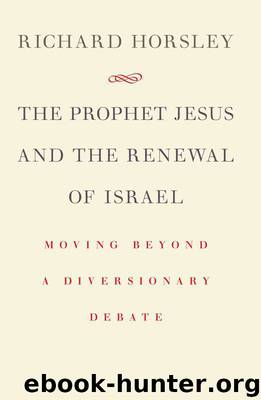The Prophet Jesus and the Renewal of Israel by Richard Horsley

Author:Richard Horsley
Language: eng
Format: mobi
Publisher: Wm. B. Eerdmans Publishing Co.
Published: 2012-11-09T00:00:00+00:00
CHAPTER EIGHT
The Gospel Sources for Jesus’ Mission
One of the most basic responsibilities of historians is to critically assess the character of their sources, as noted in Chapter 6. The principal sources for the historical Jesus are the Gospels. Yet, for various reasons, including deeply ingrained habits of reading the Bible, the Gospels were taken as mere containers of Jesus’ sayings and other bits and pieces of “data” that could be culled out of them for scholars to use in their reconstructions.
Well before the current wave of investigation of the historical Jesus gained momentum, however, other New Testament scholars were (re-) discovering the literary integrity of the Gospels as whole stories about Jesus’ mission in interactive speech and action. Perhaps most important was the recognition that the Gospels were sustained narratives comprised of many episodes that were components of the developing story and intelligible only in the broader context of the whole story.1 The Gospels, moreover, were not just one episode after another, but were stories with overall plots, in which earlier episodes and events both set up and led to subsequent episodes and events.
In the flush of discovery a generation ago, Gospel interpreters took many cues from criticism of modern narrative fiction in university departments of literary studies. The Gospels were read like modern novels or short stories, with (implied) authors, narrators, and implied readers. Interpreters looked for suspenseful plots and character development.
The Gospels, however, are different from modern novellas in significant ways. The plots of the Gospels are not linear, and are not full of suspense. Gospel stories have clear implications of how they will come out, in narratives the plots of which are known before they are read or heard. The characters are types, even stereotypes, playing important roles but not undergoing “character development.” The Gospel stories, moreover, are not comparable to modern fiction insofar as they purpose to be historical stories, indeed are filled with claims that they are the fulfillment of history. To be understood they therefore must be read in the historical context in which they are set.2 It may thus be helpful to begin with some of the fundamental questions asked of stories in Literature 101: the stories’ (historical) setting, the principal characters, and the overall plot. As the first step in approaching the historical Jesus it is necessary to take the Gospel stories whole, to appreciate their overall portrayal of Jesus’ mission in interaction with followers and the rulers of the people in the circumstances of the historical setting. Only after getting clarity on the sources will it then be possible to assess their portrayals in the historical context as known from other sources and to compare the portrayals in the different Gospels.
In order to make the project manageable and simplify the presentation we will focus on what are, by a considerable consensus, the earliest Gospel sources, the Gospel of Mark and the “source” (“Q,” short for Quelle) of the Jesus-speeches that are parallel in Matthew and Luke.
The Gospel of Mark
Mark’s story of Jesus is situated in Roman Palestine.
Download
This site does not store any files on its server. We only index and link to content provided by other sites. Please contact the content providers to delete copyright contents if any and email us, we'll remove relevant links or contents immediately.
| Guides | New Testament |
| Old Testament |
The Five People You Meet in Heaven by Mitch Albom(3476)
The Secret Power of Speaking God's Word by Joyce Meyer(2980)
Real Sex by Lauren F. Winner(2968)
Name Book, The: Over 10,000 Names--Their Meanings, Origins, and Spiritual Significance by Astoria Dorothy(2940)
The Holy Spirit by Billy Graham(2894)
0041152001443424520 .pdf by Unknown(2785)
ESV Study Bible by Crossway(2733)
How The Mind Works by Steven Pinker(2732)
Ancient Worlds by Michael Scott(2627)
Churchill by Paul Johnson(2510)
The Meaning of the Library by unknow(2508)
The ESV Study Bible by Crossway Bibles(2504)
The Gnostic Gospels by Pagels Elaine(2472)
MOSES THE EGYPTIAN by Jan Assmann(2374)
Jesus by Paul Johnson(2311)
City of Stairs by Robert Jackson Bennett(2309)
The Complete Dead Sea Scrolls in English (7th Edition) (Penguin Classics) by Geza Vermes(2237)
Ancient Near Eastern Thought and the Old Testament by John H. Walton(2196)
The Nativity by Geza Vermes(2180)
